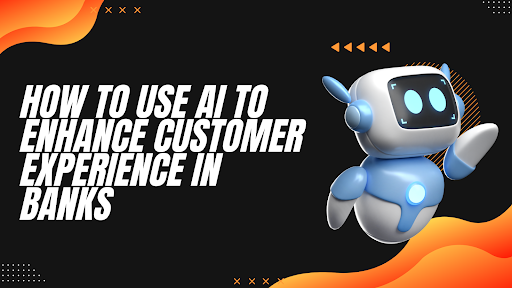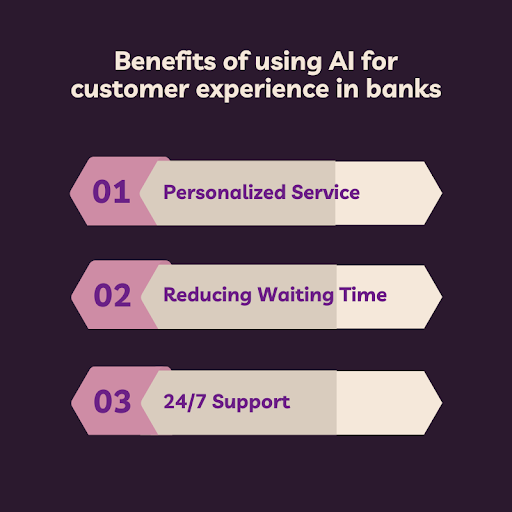Artificial intelligence is revolutionizing the way banks interact with their customers. AI has seamlessly integrated into various industries, and banking is no exception.
In this blog post, we will explore how AI is enhancing customer experience in banks, ultimately reshaping the future of financial services. Let’s dive into the world of growth hacking tools and discover how AI is taking customer service to new heights.
Benefits of using AI for customer experience in banks
AI offers numerous benefits for enhancing customer experience in banks.
- i) Personalized Service – One key advantage is the ability to provide personalized services tailored to individual customers’ needs and preferences. Through AI algorithms, banks can analyze vast amounts of data to offer targeted product recommendations and customized solutions.
ii) Reducing Waiting Time – Additionally, AI can streamline processes within banking institutions, reducing wait times for customers and improving overall efficiency. By automating routine tasks like account inquiries or transaction processing, AI frees up human agents to focus on more complex issues that require personalized attention.
iii) 24/7 Support – Moreover, AI-powered chatbots are revolutionizing customer service by providing instant support 24/7. These virtual assistants can quickly respond to inquiries, resolve common problems, and even guide users through various banking processes seamlessly.
The integration of AI in banks not only enhances customer satisfaction but also drives operational efficiencies and fosters a more personalized approach to banking services.
Personalization and customization through AI
Personalization and customization through AI have revolutionized the way banks interact with their customers. By leveraging artificial intelligence, financial institutions can now tailor services and offerings to meet individual needs and preferences.
Through advanced algorithms, AI analyzes customer behavior, transactions, and interactions to create personalized recommendations. This level of customization enhances the overall customer experience by providing relevant solutions in real-time.
AI enables banks to anticipate customer needs before they are even expressed. By understanding patterns and trends in data, personalized offers can be proactively suggested to enhance engagement and satisfaction.
Furthermore, AI-powered chatbots offer a seamless channel for customers to receive instant assistance tailored specifically to their inquiries. These virtual assistants provide personalized responses efficiently round the clock.
Personalization through AI not only improves customer satisfaction but also strengthens loyalty and trust between banks and their clients.
Streamlining processes and reducing wait times with AI
In the fast-paced world of banking, efficiency is key. With AI technology, banks can streamline their processes and reduce customer wait times significantly.
By implementing AI-powered systems for tasks like account verification, loan approval, and fraud detection, banks can automate repetitive processes that used to take up valuable time. This not only speeds up the overall customer experience but also frees up human resources to focus on more complex and value-added activities.
AI algorithms can analyze vast amounts of data in real-time, allowing banks to make quicker decisions without compromising accuracy. This means customers no longer have to endure long waiting periods for simple inquiries or transactions.
Through advanced data analytics and machine learning capabilities, AI helps banks identify patterns and predict customer needs proactively.
By anticipating these needs, banks can deliver personalized solutions faster than ever before, creating a seamless and efficient banking experience for all customers.
Case studies of successful implementation of AI in banks
Imagine a world where banks can predict their customers’ needs before they even express them. This level of personalized service is now achievable through the strategic implementation of AI technology in the banking industry.
One notable case study involves a leading bank that utilized AI algorithms to analyze customer data and behavior patterns. By doing so, they were able to offer tailored product recommendations and targeted marketing campaigns, resulting in a significant increase in customer satisfaction and loyalty.
Another successful implementation was seen in a regional bank that integrated chatbots powered by AI into their customer support system. These chatbots efficiently handled routine inquiries, allowing human agents to focus on more complex issues, ultimately improving overall service efficiency.
The impact of these implementations goes beyond just cost savings; it revolutionizes the way banks interact with their customers, creating seamless experiences that drive long-term relationships and growth.
Potential challenges and solutions when using AI for customer experience
Implementing AI for customer experience in banks comes with its own set of challenges.
- i) Accuracy & Reliability – One major hurdle is ensuring the accuracy and reliability of AI algorithms. Banks need to constantly monitor and update these systems to avoid errors that could potentially harm customer relationships.
ii) Data Privacy & Security – With AI processing vast amounts of sensitive information, maintaining strict protocols to protect customer data is crucial. Building trust with customers by demonstrating a commitment to cybersecurity becomes paramount.
iii) Employee Resistance – There may be resistance from employees who fear their roles will be replaced by AI technology. It’s essential for banks to provide proper training and education about how AI can complement human efforts rather than replace them entirely.
To overcome these challenges, banks must invest in robust testing processes, prioritize data protection measures, and offer ongoing support and upskilling opportunities for staff members adjusting to new technologies.
By addressing these obstacles head-on, banks can successfully leverage AI to enhance the overall customer experience while safeguarding privacy and maintaining employee morale within the organization.
Future possibilities for AI in the banking industry
The future of AI in the banking industry is filled with endless possibilities. As technology continues to advance, AI can revolutionize how banks interact with customers and enhance their overall experience.
- Fraud detection and prevention – By utilizing machine learning algorithms, banks can proactively identify suspicious activities and prevent potential fraudulent transactions before they occur.
- Real-time assistance – AI-powered chatbots are expected to become even more sophisticated, providing real-time assistance to customers for complex queries or issues. This will not only improve customer service but also increase operational efficiency for banks.
- Predicting user behavior – Additionally, predictive analytics using AI can help banks better understand customer behavior and preferences. By analyzing vast amounts of data, financial institutions can tailor their services to meet individual needs effectively.
In essence, the future integration of AI in the banking sector holds immense promise for creating a more personalized, efficient, and secure customer experience like never before.
Final Note
In the fast-paced world of banking, AI is revolutionizing customer experiences by offering personalized services, streamlining processes, and providing efficient solutions. By harnessing the power of artificial intelligence and chatbots, banks can enhance their customer interactions and stay ahead in a competitive market.
Embracing AI is not just a trend but a necessity for banks looking to thrive in today’s digital age. By integrating artificial intelligence into their operations, banks can better serve their customers while staying at the forefront of innovation.
By utilizing AI technologies effectively, banks can create seamless experiences for their customers that lead to loyalty, satisfaction, and sustained growth in an ever-evolving industry landscape.



Comments